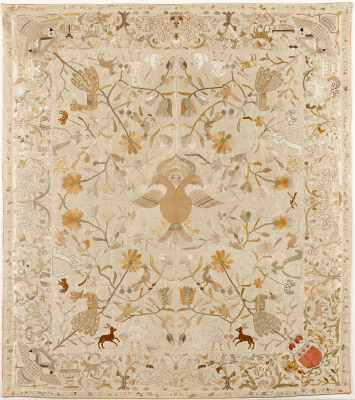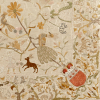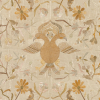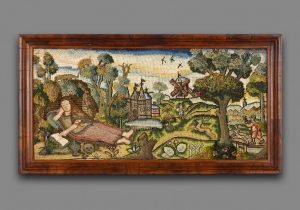Chinese embroidered silk bedspread
Chinese embroidered silk bedspread
A rectangular silk spread with richly embroidered silk decoration. In the centre of the spread is the double-headed eagle of the Habsburg Empire, surrounded by an elaborate tableau of flowers, wildlife, fowl and noble figures in hunting scenes, divided into four quarters. The whole is framed by a wide edge depicting fountains and a rich assortment of animals and mythical creatures. The double-headed Habsburg eagle is repeated at three of the corners, while the fourth bears the coat of arms of the bedspread’s recipient, the Duke of Ursel.
Conrad-Albert d’Ursel (1665-1738), Imperial Count of the Holy Roman Empire, Baron of Wesemael and Lord of Hingene, was elevated to Duke of Ursel by Emperor Charles VI in 1716, and to Duke of Hoboken in 1717. In 1726 he inherited the property of the extinct family branch of the counts of Grobbendonk. Through his marriage to princess Eleonore Christine Elisabeth von Salm-Neufville (1678-1737), the d’Ursel family also inherited the principauté d’Arches et de Charleville upon the death of her father, Charles Theodore Otto, Prince of Salm. Their descendants held the position of “Erfelijk Grootjagermeester en Opperhoutvester,” or Hereditary Grand Huntmaster and Chief Forester of the county of Flanders.
Chinese silk was highly valued in Europe for its quality and the vibrancy of its designs. Starting in the sixteenth century, Chinese silk workshops adjusted their production to suit the preferences and demands of the overseas European markets. With the European appetite for Asian goods in the seventeenth century, Chinese and Indian textiles became a popular expression of refinement and taste.
In Europe, the trade in finished Chinese silk was relatively modest: the greatest part of silk imports consisted of raw silk intended for the luxury market. Finished luxury silk products such as this commissioned bedspread are rare.
The elaborate iconography around the theme of hunting relates to the title of Hereditary Grand Huntmaster and Chief Forester of Flanders, which the family already bore in the seventeenth century. Due to the combination of the embroidery’s stylistic elements, the iconography and the coats of arms of both Emperor Charles VI and the Duke of Ursel, it is fairly certain that the bedspread dates from the year in which Conrad-Albert d’Ursel was elevated to the peerage as a duke by Emperor Charles VI. However, whether the bedspread was a gift or a piece commissioned by the new Duke himself cannot be determined.
- Period
- ca. 1720
- Material
- silk cloth, silk thread
- Dimensions
- 143 x 127.5 cm
Global shipping available











